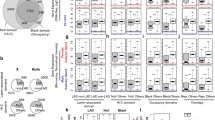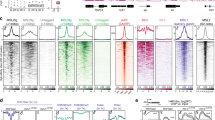Abstract
Dosage compensation refers to the phenomenon that despite the difference in copy number of X chromosomes in males and females approximately equal expression results from the sex chromosomes. We describe evidence for a model that dosage compensation is caused by an 'inverse dosage effect’ that results from an altered stoichiometry of transcriptional regulators on the X versus the autosomes. This imbalance of regulators would cause a two-fold increase in target gene expression throughout the genome in the absence of any modification. The two-fold hyperactivation compensates the X chromosome. However, the MSL (male specific lethal) complex modifies this effect on the autosomes, which would otherwise double their expression, by becoming sequestered to the X chromosome together with a histone acetylase (MOF) and kinase (JIL1). This situation reduces the level of histone 4 Lys16 acetylation and H3 phosphorylation on the autosomes, thus bringing their expression down to near the female level. The presence of the MSL complex on the X modifies chromatin in such a manner that it counteracts any impact of increased histone acetylation and phosphorylation on gene expression. This situation fosters the proper two-fold increase in gene expression needed for X chromosomal dosage compensation in males and reduces the inverse effect on the autosomes to equalize gene expression throughout the genome for the two sexes.
Similar content being viewed by others
References
Akhtar, A. & P.B. Becker, 2000. Activation of transcription through histone H4 acetylation byMOF, an acetyltransferase essential for dosage compensation in Drosophila. Mol. Cell 5: 367–375.
Arkhipova, I., J. Li & M. Meselson, 1997. On the mode of gene dosage compensation in Drosophila. Genetics 145: 729–736.
Auger, D.L., K.J. Newton & J.A. Birchler, 2001. Nuclear gene dosage effects upon the expression of maize mitochondrial genes. Genetics 157: 1711-1721.
Baker, B.S., M. Gorman & I. Marin, 1994. Dosage compensation in Drosophila. Annu. Rev. Genet. 28: 491–521.
Bell, L.R., J.I. Horabin, P. Schedl & T.W. Cline, 1991. Positive autoregulation of Sex-lethal by alternative splicing maintains the female determined state in Drosophila. Cell 65: 229–239.
Bell, L.R., E.M. Maine, P. Schedl & T.W. Cline, 1988. Sex-lethal, a Drosophila sex determination switch gene, exhibits sex-specific RNA splicing and sequence similarity to RNA binding proteins. Cell 55: 1037-1046.
Belote, J.M. & J.C. Lucchesi, 1980. Control of X chromosome transcription by the maleless gene in Drosophila. Nature 285: 573–575.
Bhadra, U., M. Pal-Bhadra & J.A. Birchler, 1998. Interactions among dosage-dependent trans-acting modifiers of gene expression and position-effect variegation in Drosophila. Genetics 150: 251–263.
Bhadra, U., M. Pal-Bhadra & J.A. Birchler, 1999. Role of the male specific lethal (msl) genes in modifying the effects of sex chromosomal dosage in Drosophila. Genetics 152: 249–268.
Bhadra, U., M. Pal-Bhadra & J.A. Birchler, 2000. Histone acetylation and gene expression analysis of Sex lethal mutants in Drosophila. Genetics 155: 753–763.
Birchler, J.A., 1977. Inverse effect regions in maize and Drosophila and their possible role in dosage compensation, sexual dimorphism of autosomal genes and sex determination in the latter. Maize Genetics Cooperation News Letter 51: 18–22.
Birchler, J.A., 1979. A study of enzyme activities in a dosage series of the long arm of chromosome one in maize. Genetics 92: 1211-1229.
Birchler, J.A., 1981. The genetic basis of dosage compensation of alcohol dehydrogenase-1 in maize. Genetics 97: 625–637.
Birchler, J.A., 1984. Genetic analysis of a modifier of the sexual dimorphism of glass in Drosophila melanogaster. Genet. Res. 44: 125–132.
Birchler, J.A. & Newton, K.J., 1981. Modulation of protein levels in chromosomal dosage series of maize: the biochemical basis of aneuploid syndromes. Genetics 99: 247–266.
Birchler, J.A., J.C. Hiebert & M. Krietzman, 1989. Gene expression in adult metafemales of Drosophila melanogaster. Genetics 122: 869–879.
Birchler, J.A., 1992. Expression of cis-regulatory mutants of the white locus in metafemales of Drosophila melanogaster. Genet. Res. 59: 11–18.
Birchler, J.A., 1996. X chromosome dosage compensation in Drosophila. Science 272: 1190.
Birchler, J.A., J.C. Hiebert & K. Paigen, 1990. Analysis of autosomal dosage compensation involving the alcohol dehydrogenase locus in Drosophila melanogaster. Genetics 124: 677–686.
Birchler, J.A., U. Bhadra, M. Pal-Bhadra & D.L. Auger, 2001. Dosage dependent gene regulation in higher eukaryotes: implications for dosage compensation, aneuploid syndromes and quantitative traits. Dev. Biol. 234: 275–288.
Bone, J.R., R.J. Lavender, R. Richman, M.J. Palmer, B.M. Turner & M.I. Kuroda, 1994. Acetylated histone H4 on the male X chromosome is associated with dosage compensation in Drosophila. Gene Dev. 8: 96–104.
Brownell, J.E. & C.D. Allis, 1996. Special HATs for special occasions: linking histone acetylation to chromatin assembly and gene activation. Curr. Opin. Genet. Dev. 16: 1176-1184.
Charlesworth, B., 1978. Model for evolution of Y chromosomes and dosage compensation. Proc. Natl. Acad. Sci. USA 75: 5618-5622.
Charlesworth, B., 1996. The evolution of chromosomal sex determination and dosage compensation. Curr. Biol. 6: 247–266.
Cline, T.W. & B.J. Meyer, 1996. Vive la difference: males v.s. females in flies v.s. worms. Annu. Rev. Genet. 30: 637–702.
Devlin, R.H., D.G. Holm & T.A. Grigliatti, 1982. Autosomal dosage compensation in Drosophila melanogaster strains trisomic for the left arm of chromosome 2. Proc. Natl. Acad. Sci. USA 79: 1200-1204.
Devlin, R.H., D.G. Holm & T.A. Grigliatti, 1988. The influence of whole-arm trisomy on gene expression in Drosophila. Genetics 118: 87–101.
Dreesen, T.D., S. Henikoff & K. Loushney, 1991. A pairingsensitive element that mediates trans-inactivation is associated with the Drosophila brown gene. Gene. Dev. 5: 331–340.
Grandori, C., S.M. Cowley, L.P. James & R.N. Eisenman, 2000. The MYC/MAX/MAD network and the transcriptional control of cell behavior. Annu. Rev. Cell Dev. Bi. 16: 653–699.
Grell, E.H., 1962. The dose effect of ma-l+ and ry+ on xanthine dehydrogenase activity in Drosophila melanogaster. Z. Vererbungsl. 93: 371–377.
Guo, M. & J.A. Birchler, 1994. Trans-acting dosage effects on the expression of model gene systems in maize aneuploids. Science 266: 1999-2002.
Guo, M., D. Davis & J.A. Birchler, 1996. Dosage effects on gene expression in a maize ploidy series. Genetics 142: 1349-1355.
Henikoff, S., 1996. Dosage-dependent modification of positioneffect variegation in Drosophila. Bioesssays 18: 401–409.
Hiebert, J.C. & J.A. Birchler, 1994. Effects of the maleless mutation on X and autosomal gene expression in Drosophila melanogaster. Genetics 136: 913–926.
Hilfiker, A.D., D. Hilfiker-Kleiner, A. Pannuti & J.C. Lucchesi, 1997. mof, a putative acetyl transferase gene related to the Tip60 and MOZ human genes and to the SAS genes of yeast, is required for dosage compensation in Drosophila. EMBO J. 16: 2054-2060.
Ising, G. & K. Block, 1981. Derivation-dependent distribution of insertion sites for a Drosophila transposon. Cold Spring Harbor Symp. Quant. Biol. 45: 527–549.
Jin, Y., Y. Wang, D.L. Walker, H. Dong, C. Conley, J. Johansen & K. Johansen, 1999. JIL-1: a novel chromosomal tandem kinase implicated in transcriptional regulation in Drosophila. Mol. Cell 4: 129–135.
Jin, Y., Y. Wang, J. Johansen & K.M. Johansen, 2000. JIL-1, a chromosomal kinase implicated in regulation of chromatin structure, associates with the male specific lethal (MSL) dosage compensation complex. J. Cell Biol. 149: 1005-1010.
Kelley, R.L., I. Solovyeva, L.M. Lyman, R. Richman, V. Solovyev & M.I. Kuroda, 1995. Expression of MSL-2 causes assembly of dosage compensation regulators on the X chromosomes and female lethality in Drosophila. Cell 81: 867–877.
Kelley, R.L., V.H. Meller, P.R. Gordadze, G. Roman, R.L. Davis & M.I. Kuroda, 1999. Epigenetic spreading of the Drosophila dosage compensation complex from roX RNA genes into flanking chromatin. Cell 98: 513–522.
Kuroda, M.I., M. Kernan, R. Kreber, B. Ganetzky & B.S. Baker, 1991. The maleless protein associates with the X chromosome to regulate dosage compensation in Drosophila. Cell 66: 935–947.
Lucchesi, J.C. & J.M. Rawls Jr., 1973. Regulation of gene function: a comparison of enzyme activity levels in relation to gene dosage in diploids and triploids of Drosophila melanogaster. Biochem. Genet. 9: 41–51.
Margolis, O.S., 1934. The effect of a supernumerary X chromosome on members of the Bar series of Drosophila. Genet. 19: 18–84.
Meller, V.H., K.H. Gu, G. Roman, M.I. Kuroda & R.L. Davis, 1997. roX1 RNA paints the X chromosome of male Drosophila and is regulated by the dosage compensation system. Cell 88: 445–457.
Muller, H.J., 1932. Further studies on the nature and causes of gene mutations. Proc. 6th Int. Congr. Genet. 1: 213–255.
Muller, H.J., 1950. Evidence of the precision of genetic adaptation. Harvey Lect. 43: 165–229.
Pal-Bhadra, M., U. Bhadra & J.A. Birchler, 1997. Cosuppression in Drosophila: gene silencing of alcohol dehydrogenase by white-Adh transgenes is Polycomb dependent. Cell 90: 479–490.
Pal-Bhadra, M., U. Bhadra & J.A. Birchler, 1999. Cosuppression of nonhomologous transgenes in Drosophila involves mutually related endogenous sequences. Cell 99: 35–46.
Rabinow, L., A.T. Nguyen-Huynh & J.A. Birchler, 1991. A transacting regulatory gene that inversely affects the expression of the white, brown and scarlet loci in Drosophila melanogaster. Genetics 129: 463–480.
Reuter, G. & I. Wolff, 1981. Isolation of dominant suppressor mutations for position effect variegation in Drosophila melanogaster. Mol. Gen. Genet. 182: 516–519.
Sabl, J.F. & J.A. Birchler, 1993. Dosage dependent modifiers of white alleles in Drosophila melanogaster. Genet. Res. 62: 15–22.
Sinclair, D.A.R., R.C. Mottus & T.A. Grigliatti, 1983. Genes which suppress position effect variegation in Drosophila melanogaster are clustered. Mol. Gen. Genet. 191: 326–333.
Smith, P.D. & J.C. Lucchesi, 1969. The role of sexuality in dosage compensation in Drosophila. Genetics 61: 607–618.
Stern, C., 1960. Dosage compensation - development of a concept and new facts. Can. J. Genet. Cytol. 2: 105–118.
Turner, B.M., A.J. Birley & J. Lavender, 1992. Histone H4 isoforms acetylated at specific lysine residues define individual chromosomes and chromatin domains in Drosophila polytene nuclei. Cell 69: 376–384.
Wang, Y., W. Zhang, Y. Jin, J. Johansen & K.M. Johansen, 2001. The JIL-1 tandem kinase mediates histone H3 phosphorylation and is required for maintenance of chromatin structure in Drosophila. Cell 105: 433–443.
Weiler, K.S. & B.T. Wakimoto, 1995. Heterochromatin and gene expression in Drosophila. Annu. Rev. Genet. 29: 577–605.
Author information
Authors and Affiliations
Rights and permissions
About this article
Cite this article
Birchler, J.A., Pal-Bhadra, M. & Bhadra, U. Dosage Dependent Gene Regulation and the Compensation of the X Chromosome in Drosophila Males. Genetica 117, 179–190 (2003). https://doi.org/10.1023/A:1022935927763
Issue Date:
DOI: https://doi.org/10.1023/A:1022935927763




